Blog
Calling for a More-Than-Human Politics
A Field Guide that can help us move towards the practice of a More-Than-Human Politics, by Anab Jain
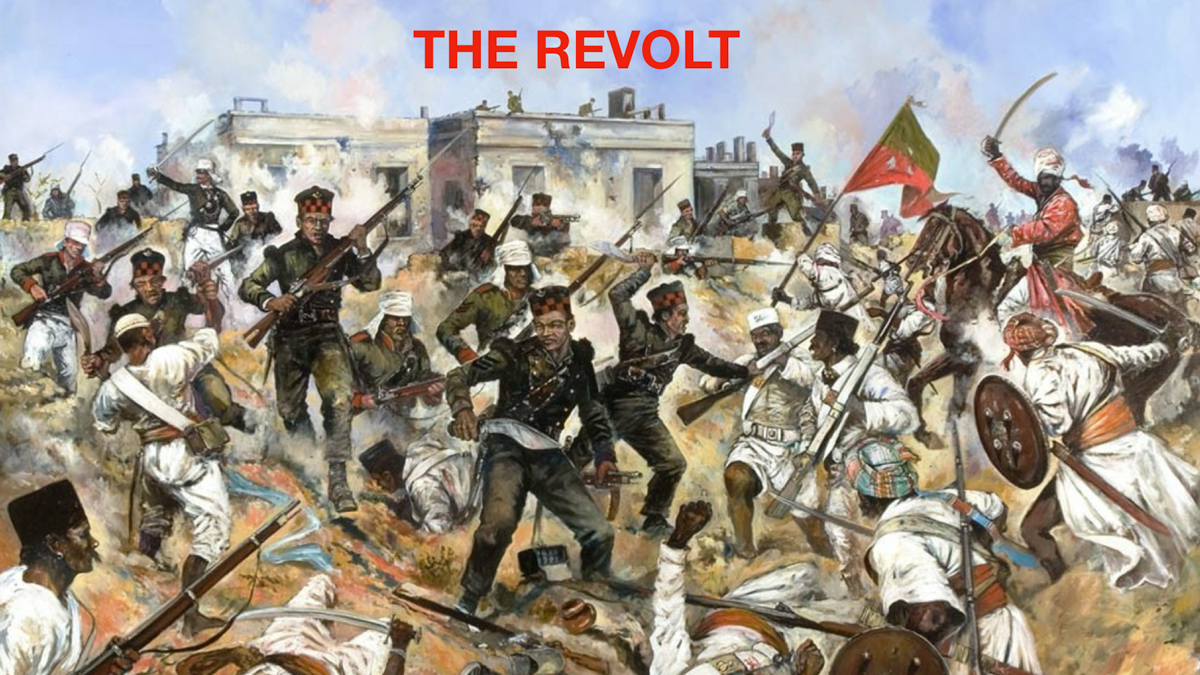
Photograph courtesy of weaponsandwarfare.com
[This is an edited transcript of Anab’s talk ‘On Critical Activism and Fungal Revolts’, presented at the Tentacular Festival, November 2019, curated by José Luis de Vicente and Julia Kaginsky.]
This is a painting of ‘The Revolt’’, or ‘The Mutiny of 1857’ as my Indian history books would say. One hundred fifty years ago it seems such events were so unheard of in that part of the world, that you could have a revolt and simply call it THE REVOLT.
So what happened? The year was 1857, and the British were rapidly, and harrowingly, colonising India. On 29th March an Indian soldier called Mangal Pandey attacked a British sergeant and wounded a soldier. Immediately, the British presiding officer General Hearsey ordered another Indian soldier to arrest Mangal Pandey, but he refused. So Mangal Pandey and the other soldier were arrested and hung, while the rest of the Indian soldiers of that regiment lost their places in the army. According to several historians, this really was a turning point in India’s fight for Independence against the British colonial power. Pandey successfully sparked a revolution, which then spread across the country. This is the history I was taught in my primary school in India. This is not the history my friends in the UK studied in their primary schools. For them, there was no mention of the long periods of Britain’s colonial rampage, apart perhaps from a fleeting mention of the glorious British Raj.
What is important to remember is that the intensity of the Revolt kicked off by Pandey was just the start. It took numerous other mutinies led by thousands of people, that finally –90 years — later, India and Pakistan got ‘independence’. Our colonial histories are dark and murky, but what seems clear is that it takes years and years of sustained belief, rebellion and hope held by millions of people, that finally leads to that moment of ‘freedom’. Revolutions are dark, murky, and can be (very) slow. Living with, and through revolutions, is an act of hope.
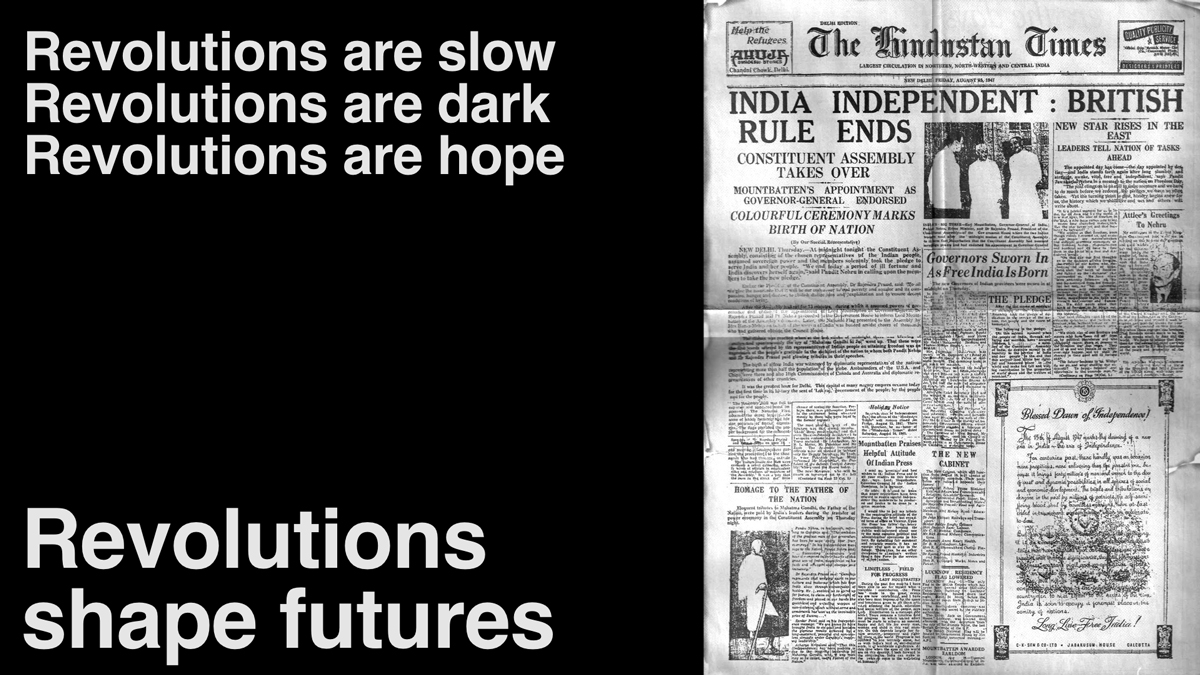
I have started with my colonial histories because I think a lot about our futures. Because, there are no futures without histories. Whilst mine was overwhelmingly dominated by a very clear revolution, with a very specific enemy who had to be ‘defeated’; today, ironically, living in Britain — who is my enemy? What is my revolt? Whom am I fighting? I deeply admire every single person who is often out on the streets fighting critically important causes, and I have joined quite a few protests myself. Although this particular form of activism might not be for everyone, it feels like so many of us, somehow, in our own way, are fighting. For those of us here in this room who are living in apparently stable ‘democracies’, we realise there isn’t one clear enemy, action, goal, victory. It’s not just data privacy, or algorithmic accountability, or labour rights or ecological crisis. Yes, ‘the enemy’ is so much more tortuous, indiscernible and faceless. (although there are a few faces of those who shall not be named that I could sucker punch).
“You cannot buy the revolution. You cannot make the revolution. You can only be the revolution. It is in your spirit, or it is nowhere.”
― Ursula K. Le Guin, The Dispossessed
And whilst I did say revolutions take time, if we listen to 97% of the climate scientists, we know that there is an undeniable urgency to change things quickly. It is this urgency I want to talk about today, about the urgency for a different kind of politics — a politics of hope, critical activism and fungal, yes fungal revolts to wrangle with the complex challenges we face.
But what does that mean? Let me illustrate with an example of one of our recent films ‘Everything Connects To Everything’, commissioned by V&A Museum. For this film, we attempted to map the complex technological, ecological and political infrastructures that lie hidden beneath a single object: the mobile phone. From our faces being mined by invisible agents to mechanical turks, undersea cable networks, bitcoin mining, server farms, factories and terraformed rare earth mineral sites, our journey revealed, in parts, the sheer scale of our entangled technological and ecological meshworks. We realised that the tools we have created to master the world are re-mastering us. But more importantly, it became evident, that the desire for mapping, tweaking and ultimately, controlling, deeply complex systems is hubristic. As Tega Brain writes in her exceptional essay “we must acknowledge how deeply entrenched we are within a computational worldview that assumes the systemacity of environments and under-acknowledges the indeterminacy of environmental encounters.”
Excerpt from our film ‘Everything Connects to Everything’ presented at the V&A Museum’s The Future Starts Here [2018]
Today the constructs that form our understanding of the world are being continually out-paced by the sheer force and speed of technological, political and social change. Modernism’s methodologies of mapping, designing, planning, for controlling and changing deeply complex systems may not be the answer to the challenges we face. Maybe we need to go underground — working in networked, symbiotic companionships, like mycelial arrangements, to generate infinite micro-revolutions.
Ecologist and scholar Tim Morton attempted to make sense of such deeply complex entanglements by coining the term ‘hyperobjects’. According to him: “We have created things that we can hardly understand let alone control, let alone make sensible political decisions about. A new word to understand how mind-blowing it is — is hyperobjects. Hyperobjects are phenomena like radioactive materials and global warming. Hyperobjects stretch our ideas of time and space, since they far outlast most human time scales, or they’re massively distributed in terrestrial space and so are unavailable to immediate experience.”
One of our recent and most ambitious works at Superflux is Mitigation of Shock (London, 2050), where we attempt to make the size and complexity of a hyperobject like climate change tangible, relatable and specific. Rather than optimistically stick our heads in the sand, or become overwhelmed with fear, we decided to catapult ourselves and others directly into a specific geographical and cultural context to experience the ripple effects of extreme weather conditions. Following extensive research and prototyping, interviews with experts from NASA, the UK Met Office and Forum for the Future, we built an entire future London apartment that has been drastically adapted for living with the consequences of climate catastrophe. Here’s a short film of the final work, where one of the inhabitants of the apartment shares their personal experience of adjusting to such a world transformed by food insecurity and climate extremities.
For this work, we spent a lot of time making and building real, fully working food computers from scratch. But apart from the growing systems, we also obsessed over every single detail in the apartment. From newspapers to books such as ‘Pets As Proteins’ and ‘How To Eat In Scarcity’, recipes, local foraging maps, neighbour’s growing notes, to-do lists in the house, ledgers, a child’s drawings and a fox skin. Not to mention the sofa, wall clock, shoes, books and clothes that we brought from our own home, so visitors could really settle in.

Images from our ‘Mitigation of Shock’ Installation at the Centre for Contemporary Culture (CCCB) Barcelona [2017–2018]
Over a hundred thousand visitors came through the apartment at Centre for Contemporary Culture (CCCB) in Barcelona, where it lived for few months, thanks to a commission by José Luis de Vicente for the show ‘After the End of the World’. This work is not a prediction, but it’s not a render either. Whilst there are fictional elements to the apartment, all the food growing systems were in full working order, no speculation there. As people spent time in the space, they found evidence of an altered life in ways they could relate to: how to cook, eat, and care for one another. There was no mention anywhere of words like ‘climate change’ or ‘global warming’, but there was enough evidence of it in ways that they could connect the dots to their own lives.
The intention of such a speculative approach with hands-on experimentation is that it offers us the opportunity to very directly step into a familiar space to confront our fears, but also show concrete ways in which we can mitigate the shock of climate change. Often, hope works best alongside tools for proactively tackling future challenges. If our work becomes a catalysing force for people to imagine things they would not have been able to imagine otherwise and act upon that imagination, then that’s powerful, and for me, this is a slow form of critical activism.
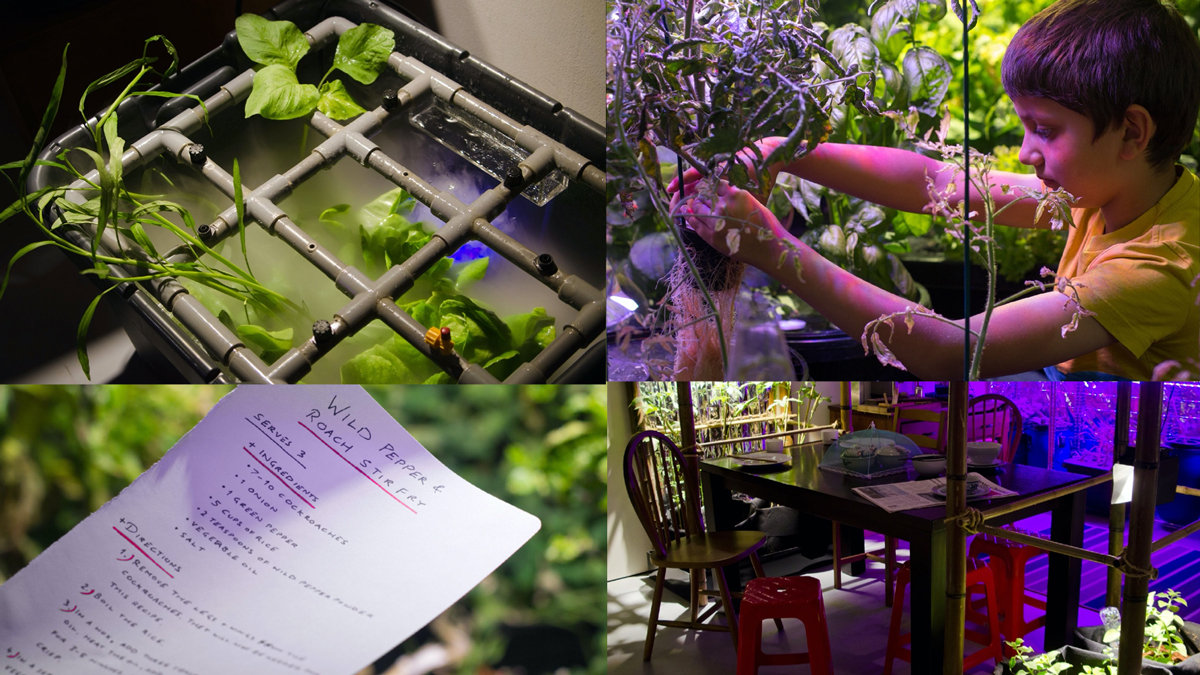
‘Mitigation of Shock’ at the ArtScience Museum, Singapore [2019–2020]
Most importantly, this work is not a one-off, but a constant work-in-progress. And as I stand here, the second episode of this show just opened at the ArtScience Museum Singapore, curated by Honor Harger and Adrian George. The installation, part of 2219: Futures Imagined, the major new exhibition at ArtScience Museum, for the Singapore Bicentennial, is set in a future Singaporean HDB apartment that looks out onto the flooded city that has been transformed to mitigate the effects of climate change. This time we wanted to move away from the dependence on the tech of ultrasonic sensors and Arduino kits needed to maintain the fogponics systems, to make the growing systems easier to grow and maintain. Inspired by permaculture, we adopted the principles of circular farming, reuse of waste, companion planting and soil health to create a permanent, indoor agriculture system, in a situation where outdoor farming is not much of an option. The idea is to make the home more of a multi-species microcosm — rather than growing systems on the periphery, you live through and amongst them.
Another thing we have done this time is to start meticulously handcrafting tools for gathering, capturing, snaring, consuming and growing food. Jon and Ed in the Studio made different types of hand whittled bamboo blades, bamboo snares with strings from abandoned fishing nets, spears made whittled bamboo, plastic waste and discarded Arduino circuit boards (which we salvaged from the first version of ‘Mitigation of Shock’). We also converted used metal tins as cooking stoves. Repurposed electronics, mechanical and plastics remnants — the detritus of the Anthropocene found a new, ritualistic purpose in this future.

Making tools from foraged materials, Mitigation of Shock, Singapore [2019–2020]
Looking out, one can see a different, very wet and humid Singapore, that despite rising sea levels and flooding, is thriving within a seemingly re-wilded landscape. Whilst extreme weather conditions, economic uncertainty and broken global supply chains have changed the world as we know it today — the sheer ingenuity of the inhabitants, their tools, artefacts, plants and new ways of living — tell a hopeful story of extreme adaptation taken to prosper in a post-climate change future.
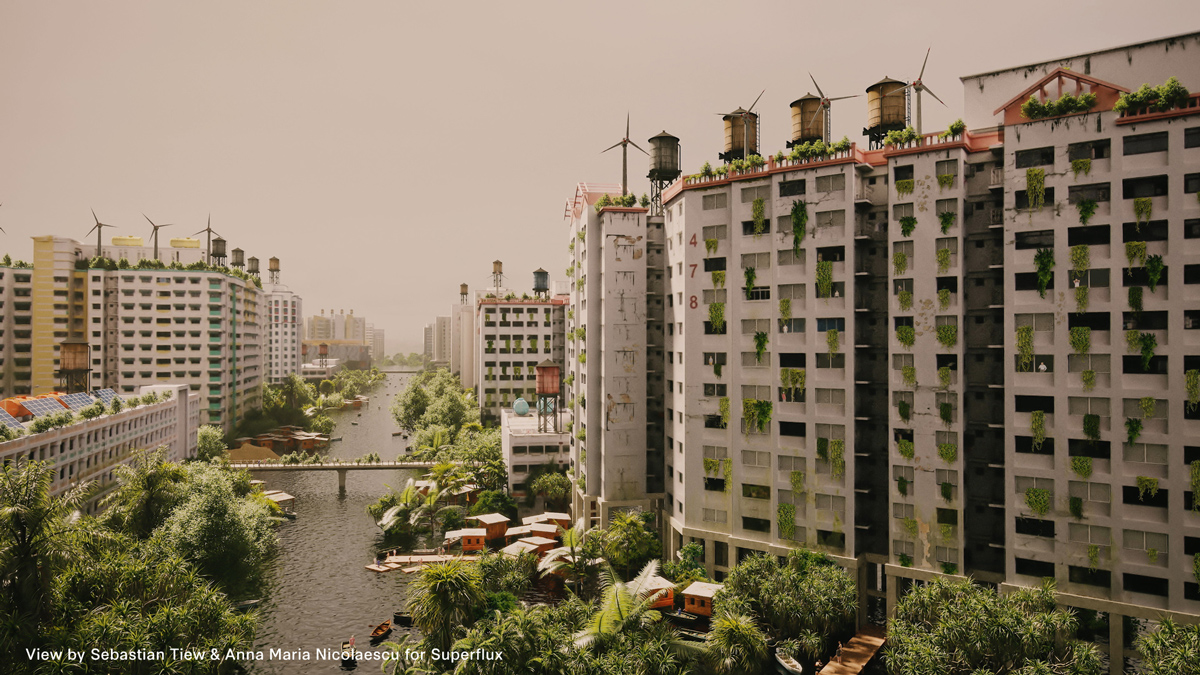
View out of the apartment window, Singapore, as part of the Mitigation of Shock installation at ArtScience Museum [2019–2020]
Why is it important to create such a detailed level of visceral, embodied form of experimentation and scene-setting?
The thing is, with global warming, the current political landscape feels extremely polarised. It is either denial that global warming exists, led by the one who shall not be named, or complete apocalypse — aka the end of the world. As we sway between doom and denial, we are stuck in what Lauren Berlant calls a ‘State of Impasse’ — a moment where existing social imaginaries and practices no longer produce the outcomes they once did, but no new imaginaries or practices have yet been created. Philosopher Isabelle Stengers writes how such a state of impasse is actively produced by the managers of the status quo — or the ‘Guardians’: When choices are presented by Guardians, they are infernal alternatives — a series of non-choices presented as choices to their various ‘publics’; the choice between doing nothing about climate change or geoengineering the climate; the choice to do nothing about deforestation or the choice to trade forests as commodities in order to preserve their ‘value’. This production of two bad alternatives, where one is ‘less bad’ than the other, is a means by which Guardians make problems inaccessible to anyone other than themselves. And so, a “cold panic” and an impotent fear of the future sets in, functionally demobilising people.”
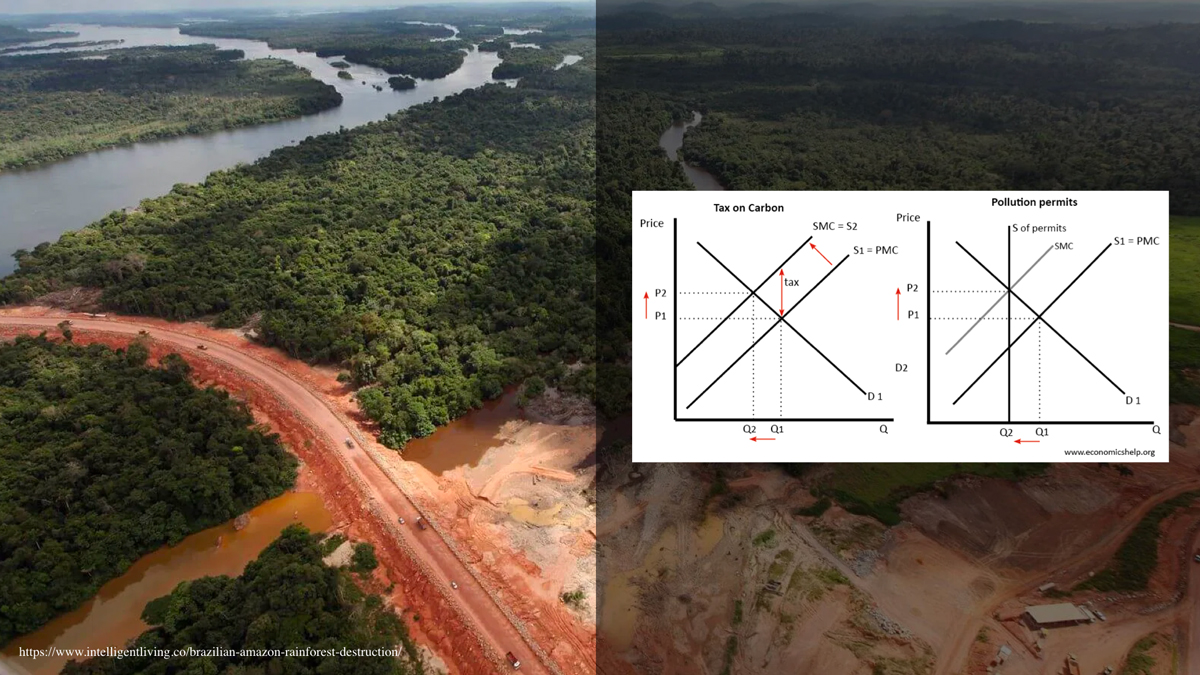
So how do we resist the gravitational pull of the impasse and deflect these invisible forces of power? How do we imagine different worlds within the current political landscape? With our practice, and works of material, and visceral realism like ‘Mitigation of Shock’, we want to write stories of extreme adaptation emerging in precarity, and thriving in the blasted ruins of capitalism. The domestic space of the apartment and its many stories bear witness to a new life emerging in instability, a life with new forms of relational agencies. It may be the end of the world as we know it, but other worlds are possible.
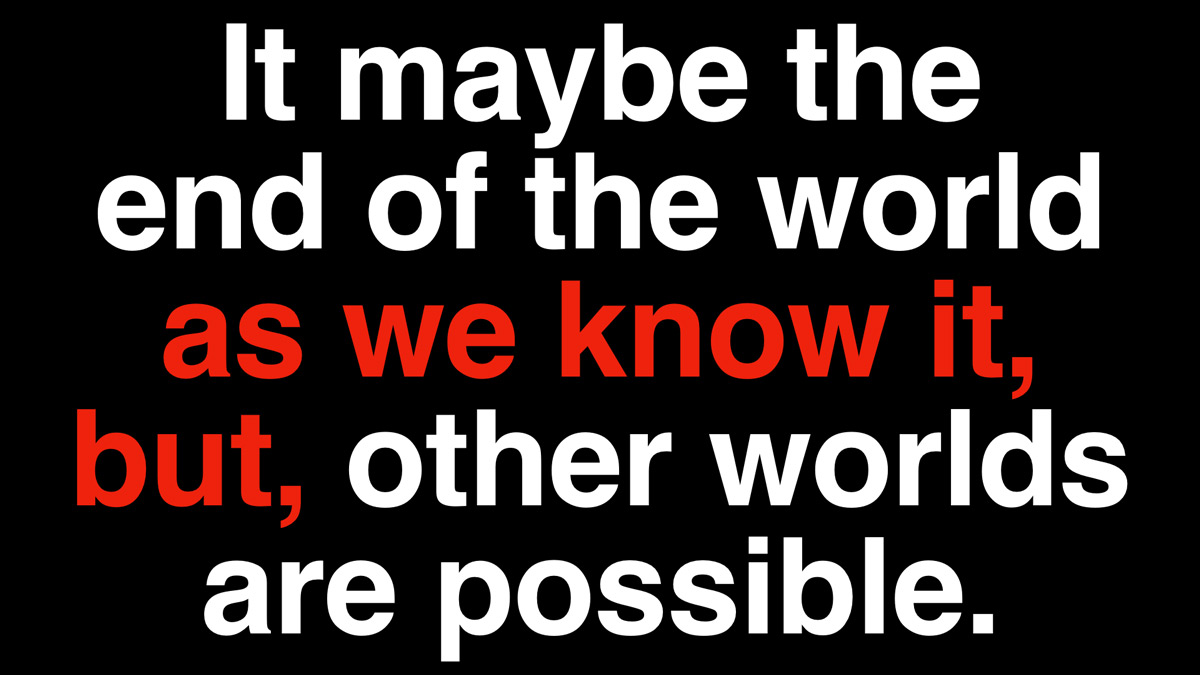
Whilst this idea of creating alternate experiential futures sounds great, it’s quite an uphill battle. We find that the desire to package these futures into neat solutions and roadmaps is overwhelmingly strong. But more than that, we have learnt that it is very difficult for people to not jump to immediate conclusions. There is a tendency to see this particular instantiation of a future presented in front of them as the future, and therefore a ‘prediction’, or be completely dismissive of it as it doesn’t align with their ideological worldview. The possibility of sitting with the discomfort of uncertainty and being open to multiple views of the world is difficult. Our prospective brains are not quite trained to maintain multiple worlds and views when simultaneously being forcefully told by all media possible what we should see, hear and believe. But, we all know, very well, the dangers of a singular narrative. Modernism was essentially an unquestioning pursuit of a ‘better future ‘ — and that is perhaps the reason we are in this situation.

Partition of India and Pakistan [1947], Wikipedia
In the beginning, I showed the glorious newspaper headlines marking India’s Independence from the British Raj in 1947, and the sheer patriotism that the Revolution for Independence festered. But Independence came at an unbearable cost. These are scenes from the partition of India and Pakistan, where 15 million displaced people displaced rushed back and forth into the countries they didn’t belong to — forced to move because their religions live on today. Another million were killed. And its roots go to the political strategy adopted by the British colonial powers — the idea of divide and rule. The idea of creating oppositional factions and then pitting them against each other.
It led to the bloody unrest and ongoing communal violence between Hindus and Muslims, which continues to date. Having grown up in Ahmedabad, the politically incited sectarian violence was a silent volcano that just needed a little ignition. That was our reality growing up — intermittent curfews and horrific riots, and in some of the worst cases, hundreds dying. (This talk was presented before India implemented the Citizenship Amendment Act and the justified outrage that followed amplifies the divide more than ever before.)
The Divide and Rule strategy adopted by the British in India (and other colonial powers) is not new. It has been attributed to Philip II of Macedon and successfully adopted by Julius Caesar and Napoleon. In his landmark essay ‘Perpetual Peace: A Philosophical Sketch’, Immanuel Kant (1795), rather cleverly, in the last appendix, lays out the THREE MAXIMS to maintain peace in the State:
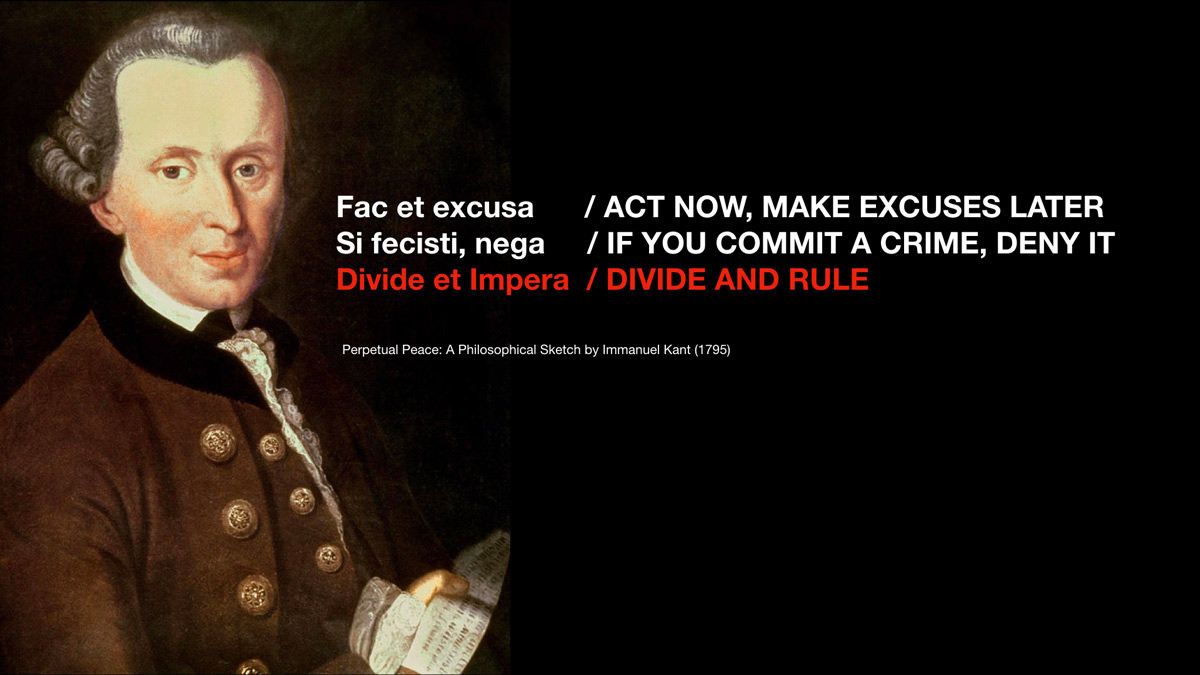
Kant noted that “the problem of setting up a state can be solved even by a nation of devils” so long as they possess an appropriate constitution which pits opposing factions against each other with a system of checks and balances.”
Pitting people, ideas and ideologies against each other is a well established, divisive, political strategy. Denialism vs doom around the climate crisis is one that I mentioned earlier, but this perpetuates down to every level. Intentionally confrontational messages and memes keep us fighting, deflecting from the attention that could be given to things that matter. Recently through a project, we had the opportunity to further explore the depths to which this happens today — increasingly by sentient, algorithmically mediated networks. Our final outcome, a film called ‘Trigger Warning’, assembled a deliberately uncomfortable, fast-paced journey through a near-future city of memes creating a visceral form to this tension — and consider where it might take us to move past this and find collective clarity and hope. The film explored how ideologies are more like memetic infections than philosophical choices: self-replicating ecologies of ideas looking for the right psychological conditions to parasitise their hosts and reproduce.

Whilst we were working on this project, we had the Brexit referendum, and all our sheltered little filter bubbles burst into millions of spiky fragments. As my peripheral vision filled up with fractious, looming anxiety, I began working on a research project and a talk about more-than human-centred design. And that’s when I revisited my friend, multi-species anthropologist Anne Galloway’s work, who was simply asking “What if we deny that human beings are exceptional? What if we stop speaking and listening only to ourselves?
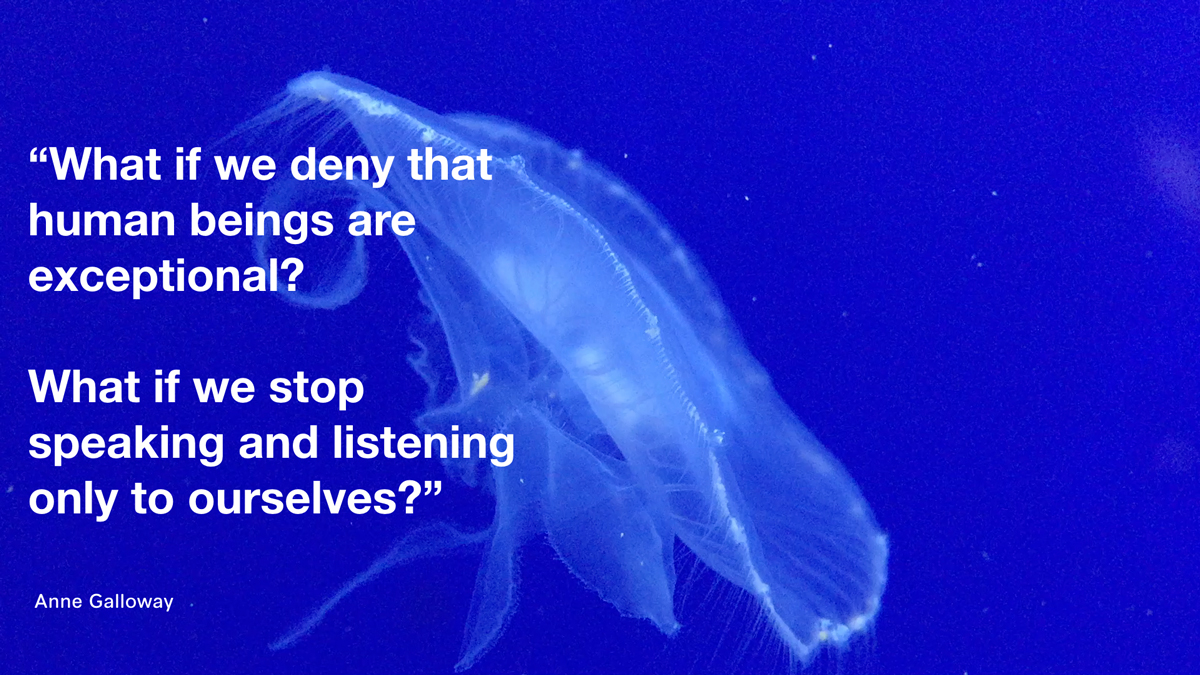
Around the same time, the mycelium in our studio also began to fruit. These were mushrooms we were desperately trying to grow nearly a year ago, for ‘Mitigation of Shock’, and were since completely forgotten.. We were using arduinos and ultrasonic fog to control the humidity in a DIY polythene clad box we built , as a sort of fruiting chamber. Whilst nothing happened for a very, very long time, the mycelium somehow resurged when it found the ‘right’ environment. Or rather our human activities and disturbances, both planned and unplanned, had created the optimum conditions for them to grow into these beautiful and rather delicious forms.

Oyster Mushrooms growing amidst disturbances, Mitigation of Shock
I realised that ‘Mitigation of Shock’ gave birth to new relationships for us, as we moved from just making things, to making things that grow. Of course, foresters grow trees, and farmers grow wheat — but within our world of design, the focus on the ‘product or artefact’ has more often than not been the embodiment of an outcome. Here, instead, we began to focus on the organism rather than the artefact. By suspending pots with seeds in basins of nutrient fog, we saw how roots were born, how they formed and grew into these delicate ecologies, how they transformed, and died, or grew incessantly. Of course I have grown things before, but this one was different. A sort of a slow epiphany if you like.

Root Ecologies, Mitigation of Shock
This direct experience drew me into the world of many interacting species. It provided a useful vantage point for knowing ourselves as participants in more complex human and non-human relationships; entangled and interdependent emotionally, economically and ecologically. In his book, The Overstory, Richard Powers writes beautifully about such multi-species interdependence.
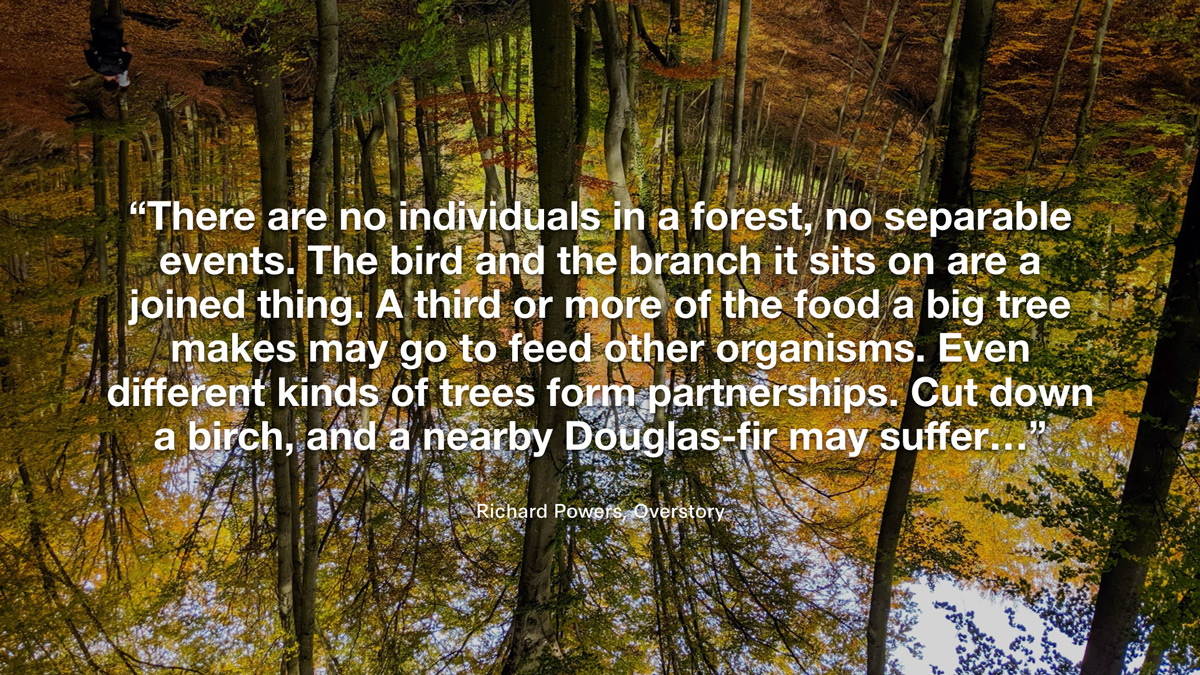
In Staying with the Trouble: Making Kin in the Chthulucene, Donna Haraway, offers yet another such perspective that favours de-emphasising human exceptionalism in favour of such multispecism. What I have understood with the idea of staying with the trouble is the opening of possibility space. If you can move beyond quick fixes, we become open to the strange and the unknown, the ambiguous and the uncertain, the weird and the provisional.
What does this mean? That attacking somebody having different views is the same as attacking yourself for feeling differently about something on a different day or realising that stripping an ecosystem, the natural resource that everyone depends on, is tantamount to cutting a piece of your flesh off to feed yourself. We are a collective body of many parts, both inside and out.
By seeing the self not as an individual hero, but as one among many — human and non-human — a new kind of tentacular, multi-kind, multi-species politics of care might emerge. A politics which does not rely on oppositional, binary, artificially constructed world views, one that is not obfuscated by the right and left or the neoliberals and communists, or whatever it is that you choose to follow. A politics that gives us a new kind of relational agency to help us imagine alternatives for living with and through global warming. A politics which allows us to invent new practices of more-than-human care, humility, imagination, interdependence, resistance, revolt, repair, and mourning.

Version 1.0 of a Field Guide for More-Than-Human Politics
This is my first attempt at assembling a Field Guide for the practice of a ‘more-than-human politics’, the start of an A/B styled manifesto that shifts our perspectives from human-centred to more-than-human worlds. This shift in perspective is not about deleting the A list, but rather, to view the B list simultaneously as an extension, a provocation, a calling. For this Field Guide, I am drawing connections between the scholarly works of Anna Tsing, Donna Haraway, Bruno Latour, Anne Galloway, as well as Tim Ingold, Robin Kimmerer, Vandana Shiva, Ursula Le Guin, Dorian Sagan, Kim Stanley Robinson and so many more.
Fixing → Caring
I start by moving away from the techno-deterministic pull of the language around ‘fixing’ and instead urge the use of ‘caring’. And here I don’t mean fixing as in fix-a-broken-website or fix-my-bike, but more in a ‘democracy is broken, no, your app will not fix it’ sort of way. Forever invoking Cedric Price, ‘Technology is the answer, but what is the question?’. When we foreground the idea of care, it inherently embodies ideas of fixing, building, making — everything necessary to-take-care-of that particular thing, person, tree, insect, bird, animal, us, them, everyone.
Planning → Gardening
Numerous people from architects to permaculturists have advocated the move from top down ‘planning’, towards the nurturing practice of gardening, when we design cities. For me this is exemplified by Chandigarh, the only city in India planned by Le Corbusier, which is highly regarded for its architectural genius, but is apparently a nightmare to live in. A top-down grid plan for a country and a people who do not live by such fixed rules, but rather have a rich history of continually adapting private, semi-public and public spaces to suit their communal needs. The most successful cities and public spaces in India are the ones where people have been able to carve out their own spaces — around banyan trees, tea stalls and at the thresholds of narrow streets. Almost like how a permaculturist might go about planting her farm.
Systems → Assemblages; Nodes → Knots
Social theorist Manuel Delanda adopted the term ‘assemblage’ to argue that social bodies on all scales are best analysed through their individual components. Like all theories, Delanda’s work has since found several critiques. However, I am particularly drawn to Anna Tsing’s use of the words ‘assemblages’ and ‘knots’ instead. When Tsing talks about assemblages she invites us to consider the open-ended and deeply entangled histories in the evolution of humans and non-humans. Assemblages are diverse, indeterminate and precarious. Our journeys through assemblages are drawn in numerous, ever-changing knots, rather than static nodes. Such a perspective brings me back to the film ‘Everything Connects to Everything Else’ and Tega Brain’s essay about the futility of the ‘systems-view’. Acknowledging the entanglements without the desire to have the ‘full overview’, keeps us open to surprising possibilities, which I find very hopeful.
Innovation → Resurgence
Innovation is a tricky one, unfortunately, co-opted by the association-of-move-fast-and-break-things as (infinite) growth, addition and mutation. Innovation fixates on new; different; change. On the other hand, ‘resurgence’ (renewing, restoring, regenerating) focuses less on endless growth and more on cyclical forms of nurturing, growing, dying and renewing. Anna Tsing writes about resurgence in the context of multispecies interdependence: “Disturbances, human and otherwise, knock out multispecies assemblages — yet liveable ecologies come back. After a forest fire, seedlings sprout in the ashes, and, with time, another forest may grow up in the burn. The regrowing forest is an example of what I am calling resurgence. […] Resurgence is the work of many organisms, negotiating across differences, to forge assemblages of multispecies livability in the midst of disturbance.”
Extinction → Precarity
Whilst the big headlines focus on the fact that we are currently in the midst of a sixth geological extinction event, and could lead to the extinction of the human species, along with many other species, I want to find other conceptual tools that might help us move forward. Not because I don’t believe that extinction could be one rather convincing, plausible future, but because I want to explore alternate proposals for working with the challenges we face. The philosophical construct of considering ‘life as precarious’ foregrounds both life and death. It focuses on how human existence is deeply interdependent with other life and therefore necessitates the need for ‘care of others’, the need for ‘being vulnerable to others’ and the need to put ‘unpredictable encounters at the centre of things’. Rather than consider a singular endpoint such as extinction, could we instead explore the possibility of life without stability, to begin with, and see where we arrive?
Global → Terrestrial; Producing → Engendering
I have never been a fan of ‘global’. And I haven’t ever been able to put my finger on what it is that unsettles me about that word (maybe it brings flashbacks of watching news on the one and only Indian national channel, Doordarshan, as newsreaders kept using the word ‘global’ in reference to North America, Europe and Australia — as if the others — Africa and Asia for instance, were outside of the ‘global.’)
Anyways, for these two frames, I am taken by Latour’s idea of ‘terrestrial’ as a move towards post-human exceptionalism. His proposal explores the possibility of ‘de-centring the human’, and acknowledging that we are in constant interaction with other beings and natural phenomena. And more importantly, a demand on the geo-social: each human activity has to be considered along with the impact it will have on the planet.
In the same frame, Latour proposes a move from ‘production’ towards more interrogative processes of questioning the ways in which things are brought to the world: existence, survival, reproducing, giving birth and losing territory. A process of engendering.
The Anthropocene → The Dithering
The Anthropocene continues to be the endearing term used — popular, specifically in academic bubbles. However, several scholars in recent history have challenged and critiqued the term ‘Anthropocene’. For instance, Jessie Beier writes how ‘one of the most troubling things about the Anthropocene is the sheer number of people it fails to trouble’. In Against the Anthropocene, T. J. Demos argues that the “Anthropocene terminology works ideologically in support of a neoliberal financialization of nature, anthropocentric political economy, and endorsement of geoengineering as the preferred — but likely disastrous — method of approaching climate change.”
So, I am reminded of Haraway’s proposal to reconsider the term Anthropocene: “We, human people everywhere, must address intense, systemic urgencies; yet, so far, as Kim Stanley Robinson put it in 2312, we are living in times of “The Dithering”, a “state of indecisive agitation.” Perhaps the Dithering is a more apt name than either the Anthropocene or Capitalocene! The Dithering will be written into earth’s rocky strata, indeed already is written into earth’s mineralized layers. Symchthonic ones don’t dither; they compose and decompose, which are both dangerous and promising practices. To say the least, human hegemony is not a symchthonic affair.”
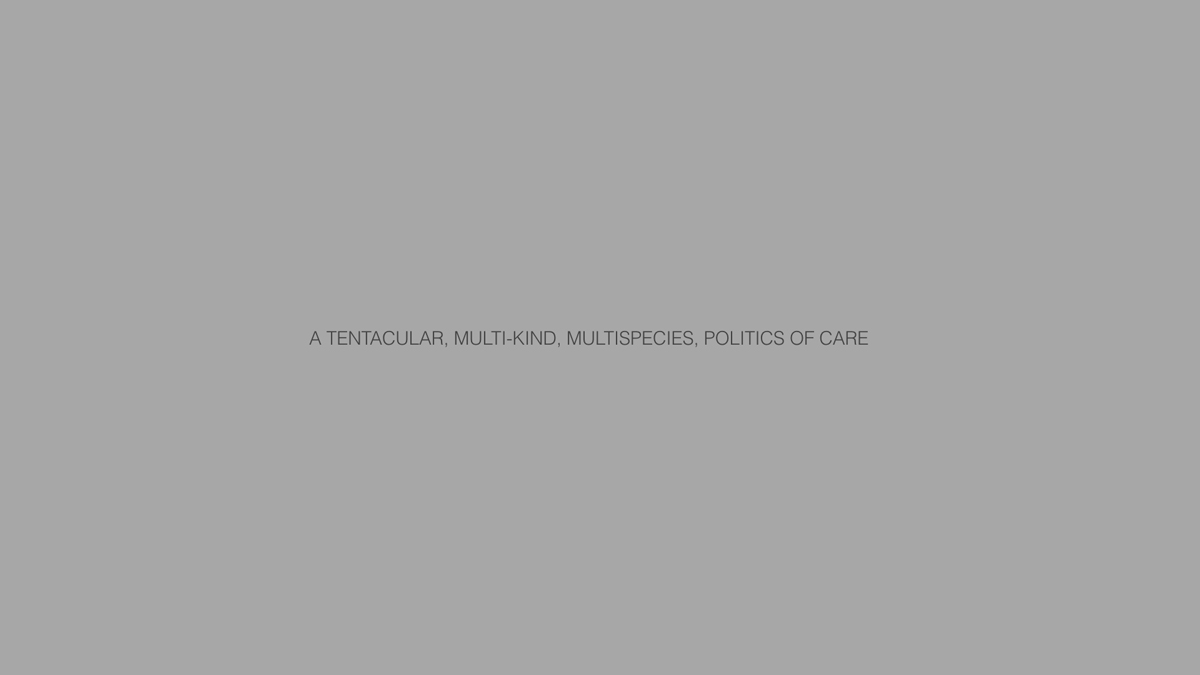
This is all I have for the moment. Moving towards the practice of a more-than-human politics is a revolt that I can get behind, because it feels like now, more than ever, we need to reject the division within ourselves, between ourselves, and from the deep ecology that sustains us. Because we don’t exist in isolation, we never have. And we are now entering a time where we face our own destruction if we continue to live in the illusion of isolation.
It is time to acknowledge the limits of anthropocentric capitalism and embrace the burden of a world that is precarious and challenging. To use our deep resourcefulness and imagination to stay with the trouble, and keep the revolt alive.
Thank you.
…
I would like to thank Jon Ardern for the many conversations that led to this talk, Nicola Ferrao for her generous proof-reading, and José Luis de Vicente and Julia Kaginsky for inviting me to Tentacular 2019.